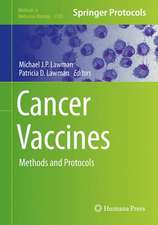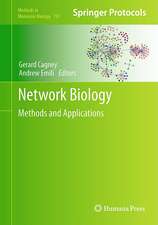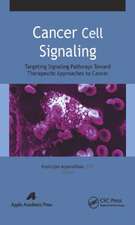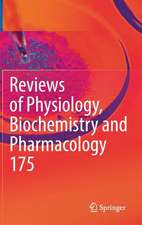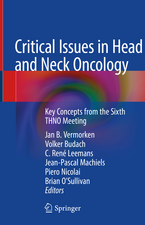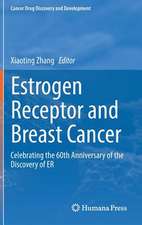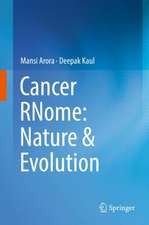Systems Analysis of Chromatin-Related Protein Complexes in Cancer
Editat de Andrew Emili, Jack Greenblatt, Shoshana Wodaken Limba Engleză Hardback – 8 aug 2013
Epigenetic modifications underlie all aspects of human physiology, including stem cell renewal, formation of cell types and tissues. They also underlie environmental impacts on human health, including aging and diseases like cancer. Consequently, cracking the epigenetic "code" is considered a key challenge in biomedical research.
Chromatin structure and function are modified by protein complexes, causing genes to be turned “on” or “off” and controlling other aspects of DNA function. Yet while there has been explosive growth in the epigenetics field, human chromatin-modifying machines have only recently started to be characterized.
To meet this challenge, our book explores complementary experimental tracks, pursued by expert international research groups, aimed at the physical and functional characterization of the diverse repertoire of chromatin protein machines - namely, the "readers, writers and erasers" of epigenomic marks. These studies include the identification of RNA molecules and drugs that interact selectively with components of the chromatin machinery.
What makes this book distinctive is its emphasis on the systematic exploration of chromatin protein complexes in the context of human development and disease networks.
| Toate formatele și edițiile | Preț | Express |
|---|---|---|
| Paperback (1) | 1096.10 lei 43-57 zile | |
| Springer – 19 aug 2015 | 1096.10 lei 43-57 zile | |
| Hardback (1) | 1101.58 lei 43-57 zile | |
| Springer – 8 aug 2013 | 1101.58 lei 43-57 zile |
Preț: 1101.58 lei
Preț vechi: 1159.56 lei
-5% Nou
Puncte Express: 1652
Preț estimativ în valută:
210.81€ • 218.75$ • 176.20£
210.81€ • 218.75$ • 176.20£
Carte tipărită la comandă
Livrare economică 17-31 martie
Preluare comenzi: 021 569.72.76
Specificații
ISBN-13: 9781461479307
ISBN-10: 1461479304
Pagini: 210
Ilustrații: XI, 316 p.
Dimensiuni: 155 x 235 x 25 mm
Greutate: 0.6 kg
Ediția:2014
Editura: Springer
Colecția Springer
Locul publicării:New York, NY, United States
ISBN-10: 1461479304
Pagini: 210
Ilustrații: XI, 316 p.
Dimensiuni: 155 x 235 x 25 mm
Greutate: 0.6 kg
Ediția:2014
Editura: Springer
Colecția Springer
Locul publicării:New York, NY, United States
Public țintă
ResearchCuprins
Preface.- Systematic proteomic analysis of histone demethylating enzymes linked to cancer.- Histone methylating protein complexes in cancer.- Chromatin protein-protein interaction networks linked to cancer.- Structural genomics and drug discovery for chromatin-related protein complexes involved in histone tail recognition.- Transcription factories and global chromatin (enhancer) interactions in cancer.- Long ncRNAs associated with chromatin complexes and their role in cancer.- Familial and somatic mutations of histone modifying enzymes in cancer.- Chromatin regulators arising from RNAi screens of transformed cancer cell lines.- Chromatin complexes in cancer.- Exploring dynamics of chromatin complexes in cancer based on quantitative proteomics.- Regulatory ncRNAs and their targets.- ncRNA regulatory networks in cancer.- Decoding BAF remodelling complexes in cancer.- Mediator/cohesin complex in cancer.- miRNAs targeting chromatin-related protein complexes regulate epigenetic states in cancer.- Polycomb group protein complexes in cancer stem cells.- Genetic interactions between chromatin factors in cancer cell lines.- Chromatin complexes in DNA repair.- Chromatin complexes in chromosome segregation.- Evolution, co-expression and domain architecture of CM complexes linked to cancer.- Index.
Textul de pe ultima copertă
Epigenetic modifications underlie all aspects of human physiology, including stem cell renewal, formation of cell types and tissues. They also underlie environmental impacts on human health, including aging and diseases like cancer. Consequently, cracking the epigenetic "code" is considered a key challenge in biomedical research.
Chromatin structure and function are modified by protein complexes, causing genes to be turned “on” or “off” and controlling other aspects of DNA function. Yet while there has been explosive growth in the epigenetics field, human chromatin-modifying machines have only recently started to be characterized.
To meet this challenge, our book explores complementary experimental tracks, pursued by expert international research groups, aimed at the physical and functional characterization of the diverse repertoire of chromatin protein machines - namely, the "readers, writers and erasers" of epigenomic marks. These studies include the identification of RNA molecules and drugs that interact selectively with components of the chromatin machinery.
What makes this book distinctive is its emphasis on the systematic exploration of chromatin protein complexes in the context of human development and disease networks.
Chromatin structure and function are modified by protein complexes, causing genes to be turned “on” or “off” and controlling other aspects of DNA function. Yet while there has been explosive growth in the epigenetics field, human chromatin-modifying machines have only recently started to be characterized.
To meet this challenge, our book explores complementary experimental tracks, pursued by expert international research groups, aimed at the physical and functional characterization of the diverse repertoire of chromatin protein machines - namely, the "readers, writers and erasers" of epigenomic marks. These studies include the identification of RNA molecules and drugs that interact selectively with components of the chromatin machinery.
What makes this book distinctive is its emphasis on the systematic exploration of chromatin protein complexes in the context of human development and disease networks.
Caracteristici
Defining high-quality protein-protein interaction networks and the physical and functional characterization of the protein machines underlying the human chromatin interactome
Identification of RNA molecules associated with various chromatin-modifying machines that direct or regulate the complexes to various target genes
Exploring the biological significance of chromatin machines in cancer (and the development and differentiation of stem cells)?
Identification of RNA molecules associated with various chromatin-modifying machines that direct or regulate the complexes to various target genes
Exploring the biological significance of chromatin machines in cancer (and the development and differentiation of stem cells)?


